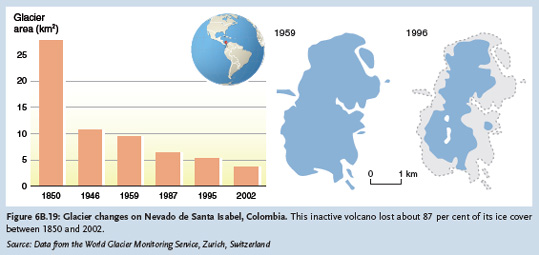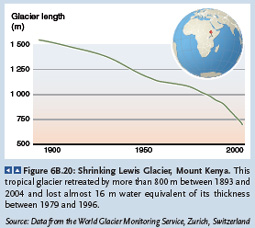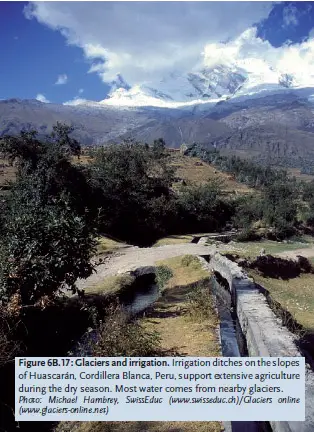Tropical glaciers are found in the high mountains of the Andes in Colombia (Figure 6B.19), Venezuela, Equador, Peru and Bolivia, as well as in the high mountains of East Africa (Figure 6B.20) and Irian Jaya, Indonesia.

 Around the period 1950–1990 they covered about 2760 km2 with about one quarter in the Peruvian Cordillera Blanca; this area had shrunk to about 2500 km2 for the period 2000–2005. The maximum extents of tropical glaciers occurred between the second half of the 17th century in Bolivia and the late 19th century in East Africa. From then, glacier shrinkage was more or less synchronous with the global one. Shrinkage rates were strongest in the 1940s, followed by a pause around the 1970s with several front advances. Since then, glaciers have again begun to retreat.
Around the period 1950–1990 they covered about 2760 km2 with about one quarter in the Peruvian Cordillera Blanca; this area had shrunk to about 2500 km2 for the period 2000–2005. The maximum extents of tropical glaciers occurred between the second half of the 17th century in Bolivia and the late 19th century in East Africa. From then, glacier shrinkage was more or less synchronous with the global one. Shrinkage rates were strongest in the 1940s, followed by a pause around the 1970s with several front advances. Since then, glaciers have again begun to retreat.
Since the publication of IPCC 2001, evidence has increased that changes in the mass balance of tropical glaciers are mainly driven by coupled changes in energy and mass fluxes related to interannual variations of regional-scale wet and dry seasons.
Variations in atmospheric moisture content affect incoming solar radiation, precipitation and albedo, atmospheric longwave emission, and sublimation. At a large scale, the mass balance of tropical glaciers strongly correlates with tropical sea surface temperature anomalies and related atmospheric circulation modes.
Glacier changes and water availability in the tropical Andes
There is growing evidence that glacier retreat in the tropical Andes has accelerated in recent decades due to atmospheric warming. Ongoing rapid glacier recession was found to have enhanced discharge at the expense of catchments storage. The recent increase in runoff is not likely to last very long. In the long run, changes in runoff may occur which could severely affect the availability of water resources for future generations, particularly during dry periods. Short-term increases in stream discharge with critical long-term loss of storage are likely to be widespread over the Cordillera Blanca region. Since glacier melt currently provides a very significant proportion of discharge of the Rio Santa River, the latter is also likely to diminish with continued glacier loss.

The melting of glaciers may lead to water shortages for millions of people. Among the Andean countries at risk are Bolivia, Ecuador and Peru, where glaciers feed rivers all year round. On the Pacific side of Peru, 80 per cent of the water resources originate from snow and ice melt. During the dry seasons, glacier-fed surface waters often constitute the sole water resource for domestic, agricultural (Figure 6B.17) and industrial uses, not only for rural areas but also for major cities. A reduced glacier runoff will aggravate the problems associated with the water availability, especially if a potential warming leads to earlier snow melt, regional reductions in precipitation and an increase in evaporation.
Material sourced from: United Nations Environment Programme (UNEP), 2007, Global Outlook for Ice and Snow, Glaciers and Ice Caps, http://www.unep.org/geo/geo_ice/
See Also
